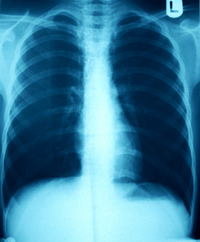Lung Diseases

Description
Lung disease refers to any disease or disorder in which the lungs do not function properly. Lung disease is the third leading killer in the United States, responsible for one in seven deaths, and is the leading cause of death among infants under the age of one. Some lung diseases, like asthma and emphysema, involve a narrowing or blockage of the airways resulting in poor air flow. Others, including pulmonary fibrosis, pneumonia and lung cancer, are caused by a loss of elasticity in the lungs that produces a decrease in the total volume of air that the lungs are able to hold. Research has shown that long-term exposure to air pollutants can reduce lung growth and development and increase the risk of developing asthma, emphysema, and other respiratory diseases. Results from the NIEHS-supported Harvard Six Cities Study, the largest available database on the health effects of outdoor and indoor air pollution, show a strong association between exposure to ozone, fine particles and sulfur dioxide, and an increase in respiratory symptoms, reduced lung capacity, and risk of early death.
Health Studies & Clinical Trials
What NIEHS is Doing on Lung Diseases
- Workshop addresses the millions who die yearly from household air pollution (http://www.niehs.nih.gov/news/newsletter/2012/11/spotlight-workshophousehold/index.htm)
- Household contaminants associated with childhood respiratory problems (http://www.niehs.nih.gov/news/newsletter/2012/11/science-householdcontaminants/index.htm)
- Early-life exposure to secondhand smoke affects girls more than boys (http://www.niehs.nih.gov/news/newsletter/2012/5/science-earlylife/index.htm)
- 12th Report on Carcinogens (RoC)
- Report on Carcinogens - 12th Edition, The (243KB)
- Profile: Report on Carcinogens: Captafol
- Addressing New Challenges in Children’s Environmental Health (314KB)
- A Human Health Perspective On Climate Change (4MB)
- Antioxidant Administration Reduces Lung Injury from Chlorine Exposure
- Carbon Nanotubes Can Affect the Lining of the Lungs
- Cardiac and Respiratory Effects of Fine Particulate Air Pollution on the Elderly
- Certain Glass Wool Fibers (Inhalable) (575KB)
- Child Development and Environmental Toxins (633KB)
- Clean Air Extends Life Expectancy
- Cystic Fibrosis
- Cytosine-DNA Methltransferase Mediates Carcinogen-induced Gene Promoter Methylation
- Environmental Public Health: The Power of Partnerships (2MB)
- Exposing Human Airway Epithelial Cells to Ricin Results in the Activation of Stress-Activated Protein Kinases & NF-κB
- Flaxseed Improves Outcome from Lung Injury
- Gene Expression Analysis for Asbestos-Induced Lung Cancer
- Formaldehyde (373KB)
- Gene May Be Linked to Lung Cancer
- Global Alliance for Clean Cookstoves
- Glutathione S-Transferase and p53 polymorphism Are Associated with Increased Lung Cancer Risk
- Identification of a Candidate Tumor Suppressor Gene in Human Lung Cancer
- Holian Discusses Lung Inflammation Caused by Nanoparticles (http://www.niehs.nih.gov/news/newsletter/2012/1/science-holian/index.htm)
- Identification of Lung Tumor Susceptibility Genes
- Immune Regulator Exerts Control over Inflammation but not Airway Hyperresponsiveness
- Living, Breathing Lung-on-a-Chip
- Lung Cancer and Cardiopulmonary Mortality in Response to Long-Term Exposure to Fine Particulate Matter
- Metallothionein is a Protective Factor in Nickel-Induced Acute Lung Injury
- MicroRNAs Modulate Smoking Damage
- Nasal Injury in Rats Exposed to Diacetyl May Be Predictive of Lung Injury in Humans
- New Treatment Found for Ozone-Caused Wheezing
- Non-Cancerous Lung Disease Caused by Arsenic in Drinking Water
- North Carolina Now Asthma Segment
- Programs and Initiatives: Climate Change and Human Health
- Respiratory Disease and the Environment (1MB)
- Styrene (248KB)
- The Ah Receptor is Essential for Mediating an Anti-Inflammatory Effect
- Unexplained Atrial Fibrillation is Associated with High Ambient Ozone
- Vitamin A Treatment and Lung Disease in Pre-Term Lambs
- Volunteers translate NIEHS cookstove research in Guatemala
- Why Me Doc? A Polymorphism in an Antioxidant Enzyme Leads to Greater Lung Cancer Risks
- Wood Stove Intervention Can Reduce Childhood Pneumonia (http://www.niehs.nih.gov/news/newsletter/2011/december/science-woodstove/index.cfm)
General Information
- Chronic Obstructive Pulmonary Disease: Learn More Breathe Better
- Environmental Health Perspectives, Environews by Topic: Respiratory Toxicity and Disease
- Household Products Database: Health Effects
- National Heart Lung and Blood Institute: National Asthma Education and Prevention Program
- Talking Glossary of Genetic Terms: Cancer
- The Interagency Working Group on Climate Change and Health (1MB)
- Public Service Video: Second Hand Smoke
- Valley Fever (77KB)
For Educators
- EHP Student Edition Lesson: Chlorine, Asthma, and . . . Blackworms? (254KB)
- EHP Student Edition Lesson: Cross Out Secondhand Smoke (135KB)
- EHP Student Edition Lesson: Human Body Systems: The Domino Effect (231KB)
- EHP Student Edition Lesson: Particles: Size Makes All the Difference (179KB)

 Back to top
Back to top